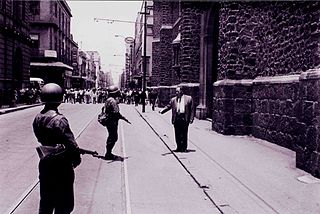 W
WThe Central American crisis began in the late 1970s, when major civil wars and communist revolutions erupted in various countries in Central America, causing it to become the world's most volatile region in terms of socioeconomic change. In particular, the United States feared that victories by communist forces would cause South America to become isolated from the United States if the governments of the Central American countries were overthrown and pro-Soviet communist governments were installed in their place. Throughout the second half of the twentieth century, the United States often pursued its interests through puppet governments and the elite classes, whose members tended to ignore the demands of the peasant and working class.
 W
WThe 1973 Chilean coup d'état was a military coup in Chile that deposed the Popular Unity government of President Salvador Allende. On 11 September 1973, after an extended period of social unrest and political tension between the opposition-controlled Congress and the socialist President, as well as economic warfare ordered by U.S President Richard Nixon, a group of military officers led by General Augusto Pinochet and Admiral José Toribio Merino seized power in a coup, ending civilian rule.
 W
WThe civic-military dictatorship of Uruguay (1973–85), also known as the Uruguayan Dictatorship, was an authoritarian military dictatorship that ruled Uruguay for 12 years, from June 27, 1973 until February 28, 1985. The dictatorship has been the subject of much controversy due to its violations of human rights, use of torture, and the unexplained disappearances of many Uruguayans. The term "civic-military" refers to the military regime's relatively gradual usurpation of power from civilian presidents who continued to serve as head of state, which distinguished it from dictatorships in other South American countries in which senior military officers immediately seized power and directly served as head of state.
 W
WThe Mexican Dirty War refers to the Mexican theater of the Cold War, an internal conflict in the 1960s and 1970s between the Mexican PRI-ruled government under the presidencies of Gustavo Díaz Ordaz, Luis Echeverría and José López Portillo, which were backed by the US government, and left-wing student and guerrilla groups. During the war, government forces carried out disappearances, estimated at 1,200, systematic torture, and "probable extrajudicial executions".
 W
WThe 1954 Guatemalan coup d'état, code-named Operation PBSuccess, was a covert operation carried out by the U.S. Central Intelligence Agency (CIA) that deposed the democratically elected Guatemalan President Jacobo Árbenz and ended the Guatemalan Revolution of 1944–1954. It installed the military dictatorship of Carlos Castillo Armas, the first in a series of U.S.-backed authoritarian rulers in Guatemala.
 W
WOperation Condor was a United States-backed campaign of political repression and state terror involving intelligence operations and assassination of opponents, officially and formally implemented in November 1975 by the right-wing dictatorships of the Southern Cone of South America.
 W
WProject Camelot was the code name of a counterinsurgency study begun by the United States Army in 1964. The full name of the project was Methods for Predicting and Influencing Social Change and Internal War Potential. The project was executed by the Special Operations Research Office (SORO) at American University, which assembled an eclectic team of psychologists, sociologists, anthropologists, economists, and other intellectuals to analyze the society and culture of numerous target countries, especially in Latin America.